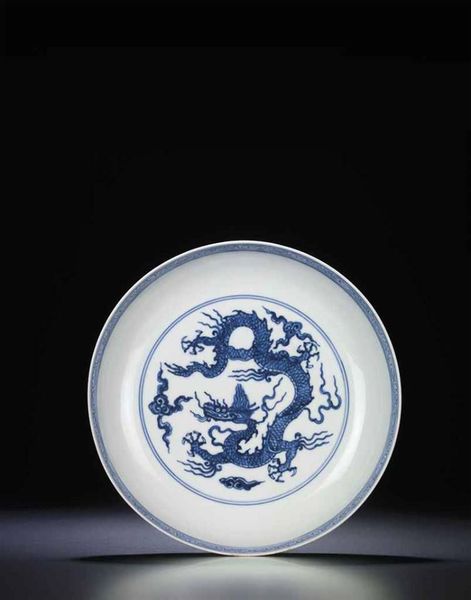An Extremely Rare Ming Blue and White ‘Dragon’ Dish, Hongzhi six-character mark within double circles and of the period
An Extremely Rare Ming Blue and White ‘Dragon’ Dish, Hongzhi six-character mark within double circles and of the period. Photo Christie's Image Ltd 2013
The dish is finely painted to the interior in cobalt of greyish-blue tone with a scaly five-clawed dragon amidst fire and cloud scrolls within double-line borders, under a band of classic scrolls around the rim. The exterior is decorated with two similar dragons pursuing 'flaming pearls' amongst clouds and fire scrolls between line borders. The tapering ring foot is encircled by a further line; 8 5/8 in. (22 cm.) diam. Estimate $77,625 - $103,499
 Notes: The current dish is a remarkably rare example of the very few extant Hongzhi-marked blue and white porcelain pieces. The Hongzhi Emperor, unlike his father the Chenghua Emperor, was known to be an austere ruler and had issued several edicts during his reign to cease ceramic production at the imperial kiln in Jingdezhen, which accounts for the general scarcity of Hongzhi-marked pieces. Blue and white wares from this period are even rarer, with Adrian Joseph speculating that there are possibly less than 20 extant pieces to date (refer to Adrian Joseph, Ming Porcelains. Their Origins and Development, London, 1971, p. 26). Three other examples bearing this rare design are known- one from the collection of R.D. Pilkington and Mrs Pilkington, illustrated ibid, fig. 41; the second and third both in the British Museum Collection and illustrated by Jessica Harrison-Hall in Ming Ceramics in the British Museum, London, 2001, nos. 7:13-14.
Notes: The current dish is a remarkably rare example of the very few extant Hongzhi-marked blue and white porcelain pieces. The Hongzhi Emperor, unlike his father the Chenghua Emperor, was known to be an austere ruler and had issued several edicts during his reign to cease ceramic production at the imperial kiln in Jingdezhen, which accounts for the general scarcity of Hongzhi-marked pieces. Blue and white wares from this period are even rarer, with Adrian Joseph speculating that there are possibly less than 20 extant pieces to date (refer to Adrian Joseph, Ming Porcelains. Their Origins and Development, London, 1971, p. 26). Three other examples bearing this rare design are known- one from the collection of R.D. Pilkington and Mrs Pilkington, illustrated ibid, fig. 41; the second and third both in the British Museum Collection and illustrated by Jessica Harrison-Hall in Ming Ceramics in the British Museum, London, 2001, nos. 7:13-14.
Most other Hongzhi blue and white examples painted with dragon motifs are decorated with dragons in a lotus pond, such as a bowl painted on the interior with a single dragon and the exterior with two dragons, as on the current dish, but all amidst lotus stalks and leaves, from the Beijing Palace Museum and illustrated inBlue and White Porcelain with Underglazed Red (II), The Complete Collection of Treasures of the Palace Museum, Hong Kong, 2000, no. 47; and a dish bearing this design illustrated in Toji Taikei, vol. 42, Tokyo, 1975, no. 74; or double dragons contesting a 'flaming pearl' on the interior and further dragons on the exterior, such as the example from the National Palace Museum, Taipei and illustrated in Blue-and-White Ware of the Ming Dynasty, Book IV, Taipei, 1963, pl. 8; or dragons amid lotus scrolls, such as the National Palace Museum example illustrated ibid, pl. 6. All the dragons on the above examples share similar traits as that on the current dish, such as small heads, narrow necks, eyes picked out as two dots within circles and scaly coiling bodies, which are all characteristics of dragons seen on Chenghua and Hongzhi wares. The current dish, with a slightly indented bottom, also conforms to Geng Baochang's observation that Hongzhi wares in general tend to have slightly convex bottoms (refer to Geng Baochang, Mingqing ciqi jianding, Beijing, 1993, p. 111).
The design on the present dish, with a single dragon on the interior and two dragons on the exterior, is based on Chenghua blue and white prototypes, such as the Chenghua-marked dish bearing the same design but with a deeper cavetto and more everted rim, from the National Palace Museum Collection, illustrated inCatalogue of the Special Exhibition of Ch'eng-hua Porcelain Ware, Taipei, 2003, no. 13. In fact Hongzhi imperial wares inherited most of the characteristics of the revered Chenghua wares, such as the highly refined porcelain and the use of local cobalt resulting in the attractive pale blue decoration seen on the current dish, which do not have the 'heaping and piling' effect seen on Yuan and early Ming blue and white wares.
Compare also to two Hongzhi-marked dishes with almost identical design as on the current dish, one decorated in green enamels, the other with the decorations reserved on biscuit, from the Shanghai Museum Collection and illustrated by Lu Minghua in Mingdai guanyao ciqi, Shanghai Bowuguan cangpin yanjiu daxi, 2007, figs. 3-75 and 3-74 respectively.
Christies. IN PURSUIT OF REFINEMENT - A LEGACY OF THE YC CHEN COLLECTION. 29 May 2013. Convention Hall

/https%3A%2F%2Fprofilepics.canalblog.com%2Fprofilepics%2F1%2F0%2F100183.jpg)
/https%3A%2F%2Fstorage.canalblog.com%2F03%2F02%2F119589%2F96711876_o.jpg)
/https%3A%2F%2Fstorage.canalblog.com%2F11%2F31%2F119589%2F94773502_o.jpg)
/https%3A%2F%2Fstorage.canalblog.com%2F20%2F83%2F119589%2F94772815_o.jpg)
/https%3A%2F%2Fstorage.canalblog.com%2F26%2F72%2F119589%2F75604929_o.jpg)
/https%3A%2F%2Fstorage.canalblog.com%2F59%2F60%2F119589%2F26458628_o.jpg)




/image%2F1371349%2F20240416%2Fob_2a8420_437713933-1652609748842371-16764302136.jpg)
/image%2F1371349%2F20240414%2Fob_83ee65_2024-nyr-22642-0954-000-a-blue-and-whi.jpg)
/image%2F1371349%2F20240414%2Fob_15808c_2024-nyr-22642-0953-000-a-blue-and-whi.jpg)
/image%2F1371349%2F20240414%2Fob_e54295_2024-nyr-22642-0952-000-a-rare-blue-an.jpg)